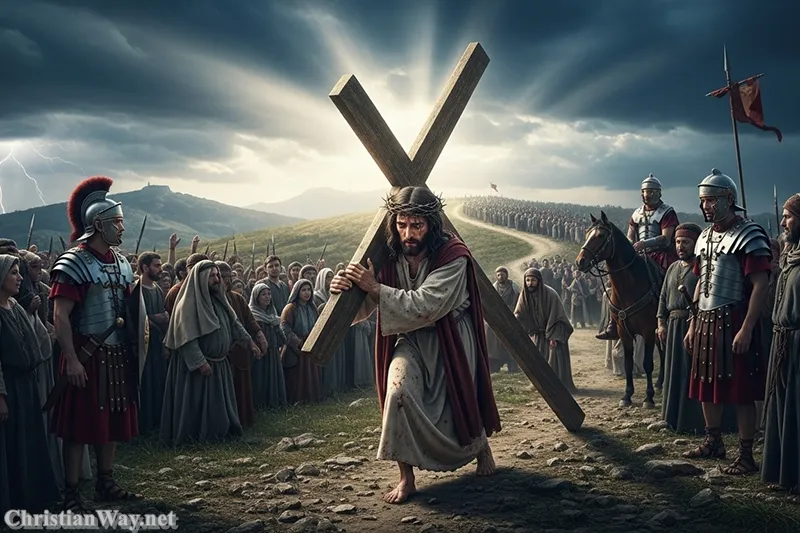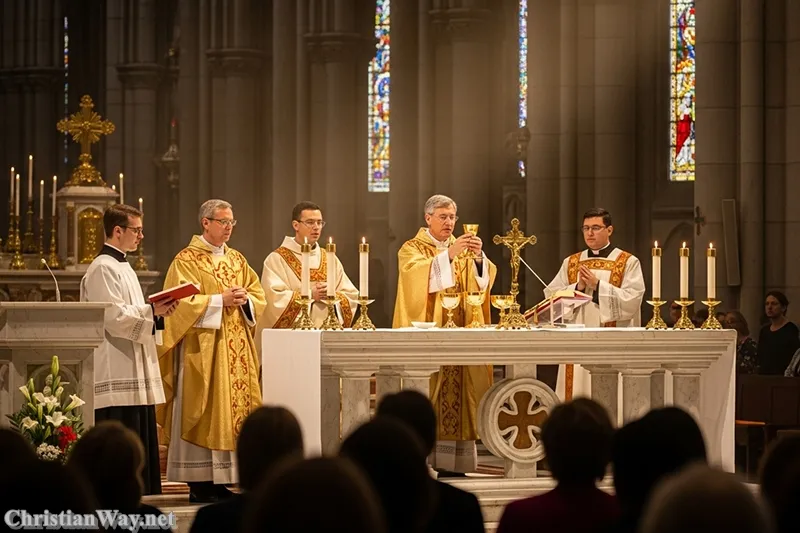Dear friends in Christ,
Every human soul, at some point in life, encounters suffering — its weight, its mystery, its seeming contradiction to love. And yet, at the center of our faith stands a Man who embraced suffering freely, transforming it into the greatest revelation of divine love the world has ever known. The Passion of Christ is not only the story of pain; it is the story of redemption. It is where the silence of God becomes the language of mercy, and where every wound becomes a door to grace.
In contemplating the Passion of Christ, we are not merely recalling a historical event. We are entering a sacred mystery — the very heart of salvation — where love chose the Cross, and death itself was conquered by the power of surrender. Every lash, every thorn, every drop of blood is a word in the eternal dialogue between God and humanity.

Let us journey together through this sacred mystery — not as spectators, but as participants who long to understand what it means that “by His wounds, we are healed” (Isaiah 53:5).
The Mystery of the Cross: Love in Its Most Radical Form
The Passion of Christ begins where human love ends — where betrayal, denial, and abandonment strip away every comfort. From the agony in Gethsemane to the final breath on Calvary, Jesus bears not only the weight of the Cross but the full burden of our sin, our fear, and our estrangement from God.
In the Garden, we see His humanity laid bare: “Father, if it be possible, let this cup pass from Me; yet not as I will, but as You will.” (Matthew 26:39). It is here that divine obedience meets human anguish. Christ does not flee suffering; He redeems it by love.
To meditate upon His Passion is to encounter the mystery of a love that does not retreat before pain but transforms it into gift. As St. Catherine of Siena wrote, “It was not the nails that held Him to the Cross, but His love for us.”
The Agony in the Garden: Where Surrender Begins
Before the scourging, before the crown of thorns, there is a garden — a place of prayer and trembling. Gethsemane recalls another garden, Eden, where humanity first chose its own will over God’s. Now, in this second garden, Christ reverses that ancient rebellion by uttering the words that heal creation: “Not My will, but Yours be done.”
In this moment, the Passion of Christ becomes the hinge of human history. Every sin born of pride and self-will meets its remedy in His obedience. Christ faces loneliness, fear, and sorrow so deep that His sweat becomes like drops of blood (Luke 22:44). Yet, in that agony, He loves still.
We who pray in our own Gethsemane moments — in sickness, betrayal, or doubt — find in Him not a distant Savior, but One who has walked the same path. He sanctifies every human fear by passing through it Himself.
The Scourging and the Mockery: Love in the Face of Violence
The Roman whip tore into His flesh; the soldiers mocked Him with a crown of thorns and a scarlet robe. Yet even here, the beauty of divine love shines forth. Christ endures humiliation not as a victim of circumstance but as the Lamb of God who takes away the sins of the world.
In every blow, love answers hatred with mercy. “He was despised and rejected by men, a man of sorrows, acquainted with grief” (Isaiah 53:3). The Passion of Christ reveals that God does not save us from suffering but through it. The very instruments of cruelty become the instruments of our redemption.
When we suffer injustice, we look to Him — the One who bore the lash without bitterness, who answered mockery with silence, who transformed pain into prayer.
The Carrying of the Cross: The Weight of the World’s Sin
On the road to Calvary, Christ carries the wood of His own sacrifice. Each step is a step into the depth of human misery — every fall a sign of His solidarity with our weakness. The Passion of Christ unfolds not in triumphal majesty but in the weary footsteps of a condemned man who loves to the end.
Along the way, He meets faces of compassion — His mother’s tearful gaze, Veronica’s cloth of tenderness, Simon of Cyrene’s reluctant strength. These small gestures of love pierce through the cruelty of the crowd, showing us that even amid the world’s darkness, the light of charity is never extinguished.
We too are called to walk the Way of the Cross, not to add to His suffering but to unite ours with His — that we might, through His grace, share in His victory.
The Crucifixion: Love Crucified
Here, on the hill of Calvary, heaven and earth meet. The nails pierce His hands and feet; the Cross is raised between two thieves; and in the stillness of that terrible hour, Love reigns.
“Father, forgive them, for they know not what they do.” (Luke 23:34) — this cry is the gospel in its purest form. The Passion of Christ reveals a God who forgives even as He bleeds, who opens paradise to a repentant thief, and who entrusts His mother to the care of humanity: “Behold, your mother.” (John 19:27)
When He utters, “It is finished” (John 19:30), it is not the cry of defeat, but of completion — the fulfillment of every prophecy, the sealing of a new covenant, the victory of love over sin. The Cross becomes the throne of the King who conquers not by might, but by mercy.
The Death of Christ: The Silence of God
When Jesus bows His head and gives up His spirit, the world falls into holy silence. The curtain of the Temple is torn in two, and the earth trembles — as if creation itself mourns its Creator. Yet, in this silence, something immeasurable occurs: death itself is conquered from within.
The Passion of Christ shows us that even in apparent defeat, God’s plan is unfolding. The silence of Holy Saturday — the tomb’s stillness — becomes the seedbed of resurrection. Every human despair finds hope here. For the One who entered our darkness now fills it with light.
The Meaning of the Passion for Our Lives
To meditate on the Passion of Christ is to understand that suffering, when united with love, becomes redemptive. The Cross teaches us that pain is not meaningless when carried with faith. It becomes a bridge between our weakness and God’s grace.
Each of us bears a cross — illness, loneliness, loss, guilt, or fear. Yet, when we gaze upon the crucified Christ, we see not a symbol of defeat, but the sign of divine companionship. He is not above us in our suffering; He is with us in it.
St. Paul understood this deeply: “I have been crucified with Christ; it is no longer I who live, but Christ who lives in me.” (Galatians 2:20). The Passion invites us not to avoid suffering, but to allow it to be transformed — to let love make of it something holy.
The Passion in the Life of the Church
Every Mass is a living memorial of the Passion of Christ. When the priest raises the Host, the sacrifice of Calvary is made present once more — not repeated, but re-presented. The Eucharist is the fruit of the Passion: the gift of His Body given for us, His Blood poured out for many.
In the sacraments, in prayer, and in acts of love, the Passion continues to bear fruit in the life of the Church. Each generation of believers finds strength in the Cross — from the martyrs who gave their lives for Christ, to the humble souls who suffer silently for love of Him.
The saints remind us that to follow Christ is to carry the Cross — not as a burden of despair, but as a path to glory. For after every Good Friday comes Easter morning.
The Passion and the Modern Soul
In our modern age, the Cross can seem a scandal — a symbol of weakness in a culture that worships power and pleasure. Yet the Passion of Christ speaks with renewed urgency to a world that has forgotten how to love sacrificially.
When we see violence, betrayal, and cruelty in our own time, we can recall that the world has always been capable of such darkness — and yet Christ has overcome it. His Passion reminds us that love alone can redeem what hatred destroys.
In a time of loneliness and disillusionment, the Cross still stands as the sign of a God who does not abandon us. He does not promise an easy life, but a redeemed one — a life where every sorrow can find meaning in His wounds.
Reflect and Pray
Dear brothers and sisters, to gaze upon the Passion of Christ is to look into the very heart of God. It is to understand that love is stronger than death, and mercy deeper than sin.
As you meditate on His suffering, let it not end in sorrow alone, but awaken within you a deeper gratitude, a greater trust, and a renewed desire to love as He has loved you.
Let us pray:
Lord Jesus Christ,
You carried the Cross for love of us.
Teach us to carry ours with faith and patience.
When we fall, lift us by Your grace;
when we fear, remind us of Your mercy;
and when we suffer, unite our hearts to Yours.
May Your Passion be our hope,
and Your Resurrection our joy,
now and forever. Amen.
— Fr. John Matthew, for Christian Way





